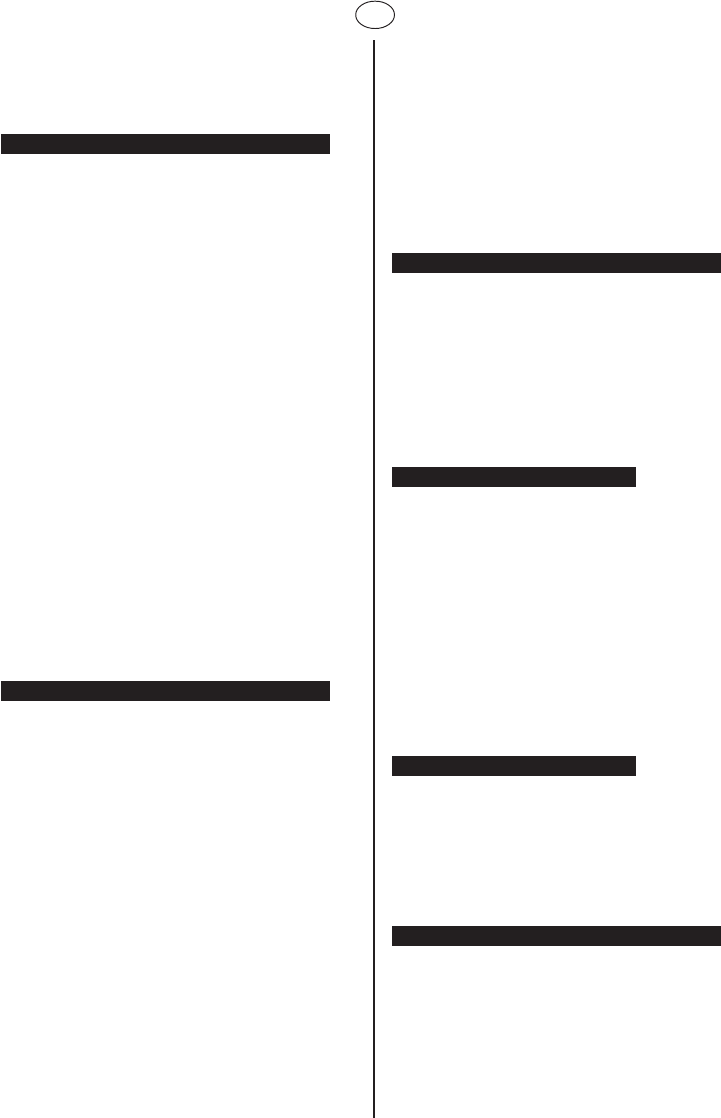
Consult the designs in the front pages referenced in the text by
alphabet letters. Closely follow the instructions set out in this
manual. All responsibility, for any eventual inconveniences,
damages or fires caused by not complying with the instructions in
this manual, is declined.
Introduction to the Hood - Fig. 1
1. Light Switch
2. Motor Speed Switch
3. Light Covers - illumination of the Cooking Surface
4. Grease Filters
5. Grease Filter Support Grate (the grease filters are located
within).
6. Light Cover Supports
7. Pull-Out Drawer
Model with Self-supporting Metal Filters
Removing the Grease Filters - Fig. 2
a. Remove the pull-out drawer completely.
b. Press the side handles (A) towards the opposite side and
remove the filters.
Putting the Filters Back in Place
a. Remove the pull-out drawer completely and mount the grease
filter so that it covers the drawer.
b. Close the drawer and install the remaining grease filter.
Opening the Light Cover Support
a. Remove the pull-out drawer completely.
b. Push the B knobs inwards toward each other (in the Open
direction as indicated on the plastic knob itself).
Model with Grease Filter Support Grate
Opening the Grease Filter Support Grates - Fig. 3
a. Remove the pull-out drawer completely.
b. Push the B knobs inwards toward each other (in the Open
direction as indicated on the plastic knob itself).
c. To remove the grates completely, use the N spring fasteners,
which act as pins to hold the grate in place (Fig. 4).
Systems Available
Two systems are available:
Venting Outdoors
The air is vented outdoors through a duct which must be connected
to the exhaust opening (C - Fig. 5) by means of the flange (D). The
diameter of the exhaust duct must be exactly the same as that of
the flange.
Air Recirculation
The air is cleaned by means of charcoal filters (one or two
depending on the model) and then circulated back into the
room.
The use of a charcoal filter is necessary when the hood cannot
vented outdoors either because ducting is not available or
cannot be installed.
The filtered air is returned from atop the cabinet through a duct
that passes through the cabinet itself.The diameter of the duct
must be the same as that of flange D (Fig. 5).
The installion (or removal) steps are identical for hoods with either
1 or 2 motors:
a. Request a charcoal filter from the retailer, specifying the
model and type of hood (1 filter for a hood with one motor and
2 filters for a hood with 2 motors).
Caution! Some charcoal filters come covered with a plastic film to
protect their filtering properties. If this is the case, remove the
film before installing the filter.
b. Remove the pull-out drawer completely.
c. Remove the grease filters or the grates.
d. Open the light cover support.
e. Install the charcoal filter so that it covers the plastic grate
which protects the ventilation fan (Fig. 6).
f. Turn the center handle in the clockwise direction until it locks
in place.
g. Remount the grease filters and the grates.
Installation
When installed, the distance between the hood and burners must
be not less than 65 cm for electric burners or 70 cm for gas or
mixed-fuel burners.
If the instructions for installation for the gas hob specify a greater
distance, this must be adhered to.
Do not tile, grout or silicone this appliance to the wall. Surface
mounting only.
Do not fix chimney flue to furniture or fly over shelves unless the
chimney flue can be easily removed, in case maintenance is ever
required.
Caution
This appliance is designed to be operated by adults. Children
should not be allowed to tamper with the controls or play with the
appliance.
Do not use the cooker hood where the grill is not correctly fixed!
The suctioned air must not be conveyed in the same channel used
for fumes discharged by appliances powered by other than
electricity. The environment must always be adequately aerated
when the cooker hood and other appliances powered by other than
electricity are used at the same time. Flambé cooking with a
cooker hood is prohibited. The use of a free flame is damaging to
the filters and may cause fire accidents, therefore free flame
cooking must be avoided. Frying of foods must be kept under close
control in order to avoid overheated oil catching fire. Carry out
fumes discharging in accordance with the regulations in force by
local laws for safety and technical restrictions.
Electrical connection
The electrical tension must correspond to the tension noted on the
label placed inside the cooker hood. Connect the electrical plug,
where provided, to the an easily accessible outlet in conformity
with local standards in force.
Where an electrical plug is not provided (for direct connection to
electrical network) place a standards approved bipolar switch with
an aperture distance of not less than 3mm (accessible) from the
contacts.
Mounting the Hood
The diameter of the ventilation duct must be the same as the that
of the flange mounted on the ventilation hole on the hood. The
horizontal sections of the ducting must be installed at a slight angle
(about 10%) to facilitate venting the vapours and fumes outdoors.
To mount the hood proceed as follows:
a. Drill holes in the bottom of the cabinet so that they correspond
with the holes (F) in the hood used to fasten it to the cabinet.
Use the drilling template if it has been provided (the edge with
the arrow should correspond with the back edge of the cabinet
- Fig. 7).
GB


















